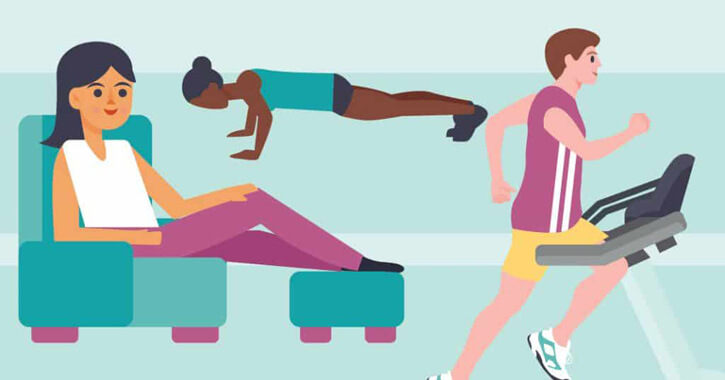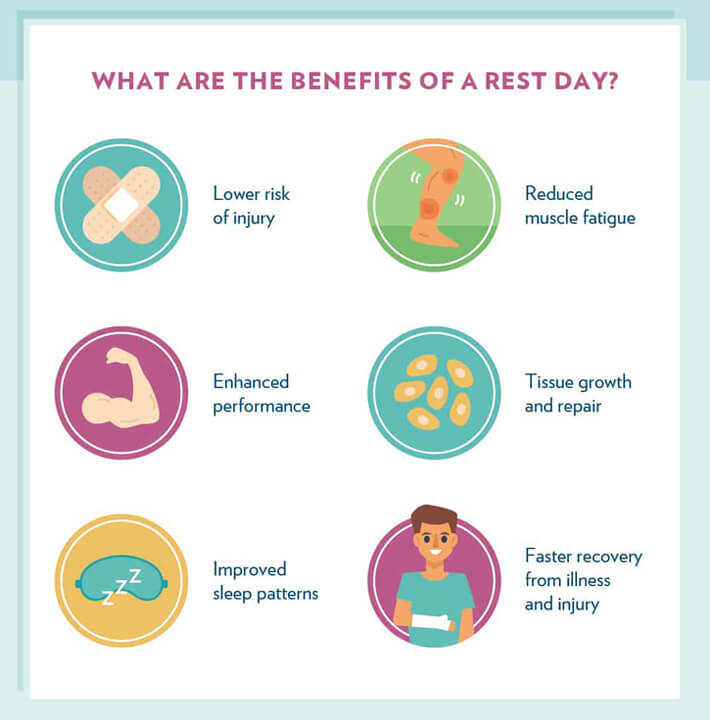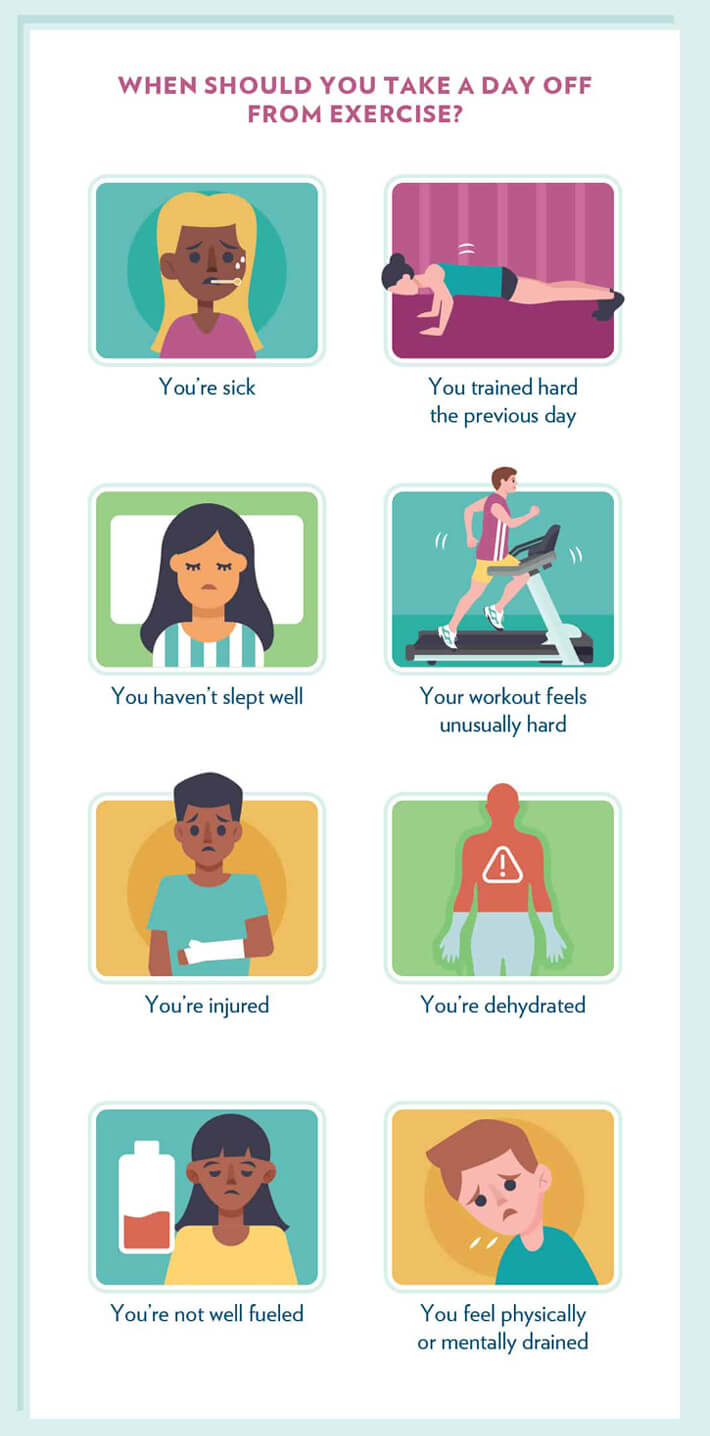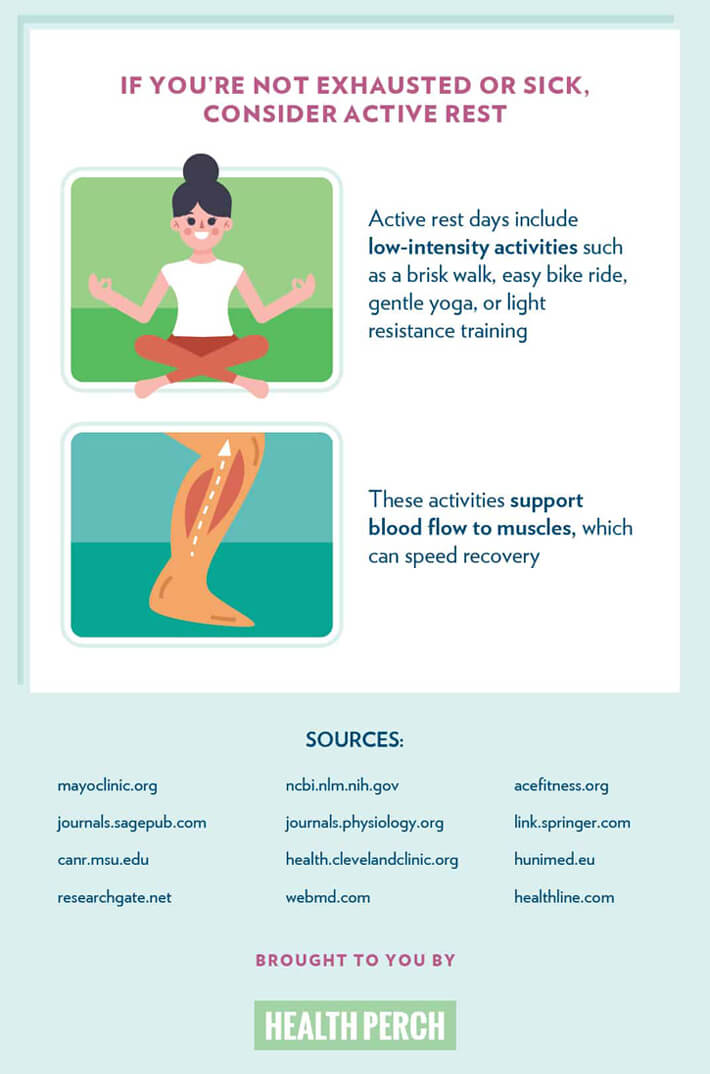Those training shoes call to you from the corner. Some days you feel all in, while other days you need an extra push to get going. Maybe you lack motivation, feel under the weather, or need to recover. No matter the reason, when you find yourself without the desire to lace up, it’s a good idea to check in and see if you need time off.
Is today one of those days? Read on to find out how rest days benefit you, plus learn eight situations when you should go ahead and give your body a break from exercise.
What Are the Benefits of a Rest Day?
We all understand the importance of regular exercise. But rest days are just as essential as your weekly workout routine. Breaks between sweat sessions allow your body to heal and repair, and they also help prevent burnout.
A good solid rest day provides several benefits.
- Lower risk of injury
Training too frequently can lead to repetitive stress and strain on your muscles and joints. In the long run, overtraining will force you to take more time off, because you’ll be more likely to have injuries. Schedule regular rest days now so you don’t deal with negative consequences in the future.
- Reduced muscle fatigue
Exercise takes a lot out of you, especially your muscles. Rest allows your body to restore glycogen, the energy stored within muscles that is used for performance. When your muscles get adequate rest, your body can perform at its peak because you’ve effectively replenished energy stores.
- Enhanced performance
When you push through workouts every day, it can decrease your level of output, meaning your body has a hard time keeping up with the demands of your workouts. Regular rest days allow your body to recover so you can push to new fitness levels.
- Enhanced tissue growth and repair
Exercise creates microscopic tears in muscle tissue. At rest, the body is able to repair tears and make the muscle tissue stronger. In other words? Less exercise could lead to greater muscular gains.
- Improved sleep patterns
Exercise is great for sleep, but rest also improves sleep quality. When you take a day off between workouts, it allows your body to restore normal hormone levels. Healthy hormone levels maintain regular sleep-wake cycles and support overall sleep quality.
When Should I Take a Day Off from My Workout Routine?
Sometimes we make excuses for ourselves, such as “It’s raining,” or “The new season of my favorite show just dropped.” But other times, we legit need a rest day because our body (or brain) says so.
Here’s when to chill out, even if you’d planned to work out.
1. You’re sick.
Your immune system works hard to restore your body when it’s sick. Exercise increases physiological stress, and stress can wreak havoc on your immune system. So if you’re sick, it’s better to use that energy to heal your body. Plus, if you work out in a shared space, it’s important to protect others around you. Keep those germs to yourself.
2. You trained hard the previous day.
Whether it was a grueling workout session, your longest run, or a competition, take the day off if you trained hard the day before. The body takes a beating when you train hard, and extra down time will help your muscles recover faster.
3. You haven’t slept well.
Pushing through a workout when you haven’t slept well can make your workout harder. Even mild bouts of sleep deprivation can impair exercise performance, mainly because sleepiness reduces motivation. When you’re sleepy and not as mentally sharp, you’re also more at risk of accidents or injury.
4. Your workout feels extra hard.
If your workout seems 10 times harder than usual, your body probably needs a break. You won’t win every workout, but pushing through when your body tells you “no” can lead to a series of lackluster performances.
If you often feel dizzy or lightheaded, or get leg cramps, consult your doctor to rule out more serious issues.
5. You’re injured.
If your injury is fresh, it’s best to rest while inflammation calms down. The body uses a good amount of energy during its healing process, and if you push through an injury you could extend the amount of time it takes to heal. That means you may be sidelined for even longer than necessary.
6. You’re dehydrated.
Even mild dehydration can affect exercise performance (especially when you work out in the heat), so it’s important to stay well-hydrated all day. Though hydration requirements differ for everyone, it’s helpful to keep a water bottle with you at all times and sip throughout the day.
7. You’re not well fueled.
It’s not always easy to time your meals around workouts. But if you haven’t fueled up enough during the day, you may want to call off your training session. Working out when you haven’t eaten in a while may lead to lower strength, stamina, and even more serious issues such as drops in blood sugar.
One exception is intentional fasted training. This is more of personal preference and should be part of a plan, not something you do because you’re busy and don’t have time to eat.
8. You feel physically or mentally drained.
We all experience different degrees of tiredness. If you’re just feeling a bit lazy, you can probably push through a workout. But if you feel physically or mentally exhausted, give your body a break. It’s important to identify the root cause of your exhaustion if it lasts for more than a few days.
When to Consider Active Rest
Recovery doesn’t always mean inactivity. Some days, your body will need total passive rest (especially if you’re exhausted or sick). But on others, active rest may boost your exercise performance the next time you train hard.
Active rest days include some type of low-intensity activity that keeps your blood flowing to help your muscles recover faster. The goal of active recovery is to be gentle enough to allow muscles recovery time but also active enough to support blood flow to the muscles, which helps them heal.
Active recovery can include the following:
- Light cardio such as a brisk walk, easy bike ride, or low-impact cardio equipment such as a rowing machine (low-intensity, of course)
- Gentle flow or yin yoga
- Mobility, flexibility, and core activation exercises
- Light resistance training
Conclusion
Let your body be your guide when it comes to rest days. A little time off can go a long way when it comes to recovery and rejuvenation, especially if you’re not feeling well or if you recently completed a heavy bout of exercise. If you decide to do an active recovery day, make sure it feels like a break from your normal routine. That way, you’ll feel stronger than ever the next time you tackle an intense workout.
Kellie Davis ran before she crawled and is constantly feeding her insatiable appetite for competition. In 2009, she competed in her first figure bodybuilding show and subsequently started a fitness blog titled MotherFitness.com to help other moms and career women make positive fitness and lifestyle habits. Her blog spring-boarded her fitness writing career, and shortly after she was in the gym coaching clients. Davis discovered the perfect marriage of fitness and writing, and has since co-authored the popular women’s strength training book Strong Curves, launched a handful online fitness programs, and is also the co-founder of GetGlutes.com, a comprehensive intermediate resistance training system. As a fitness writer and personal trainer, she is known for helping hundreds of women achieve optimal health through her innovative fitness programs designed for those with a busy lifestyle. In her spare time, Davis dotes on her amazing husband and two children, attends The George Washington University as a graduate student, competes in powerlifting, takes the field in co-ed softball, and spends time with her two adoring dogs and brood of backyard hens.
Original article can be viewed in its entirety here.








